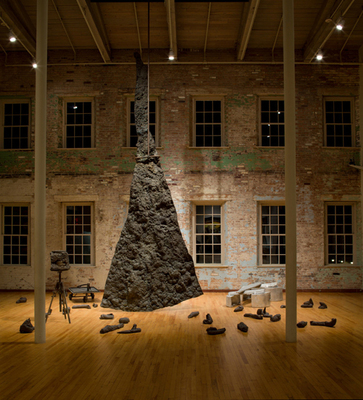
Description
The work of European sculptor Joseph Beuys is grounded in a tradition of narrative sources that is often absent in American art of the same period. The historic symbolism of Northern Europe, Christianity, and an invocation of the spiritual power of animals and nature course throughout Beuys' diverse activities, from performances and lectures to sculptures and drawings. For Beuys, all these works share a common purpose: "the victory of socialist warmth and self-determination over materialist greed and alienation."
Beuys' dramatic Lightning with Stag in its Glare, (Blitzschlag mit Lichtschein auf Hirsch), 1958-85, is the only environment that the artist cast in bronze. An offspring of Beuys' seminal Workshop exhibition at the Martin-Gropius-Bau in Berlin in 1982, this monumental work is encrusted with layers of meaning. At its core, it enacts a dramatic moment in nature: A bolt of lightning (the large, suspended sculpture) strikes the ground, illuminating a stag (cast in highly reflective aluminum). Other animals are present, but are not so well illuminated. There is a goat (a metal cart with a pick resting on it) and worm-like primordial animals (the dark bronze forms scattered on the floor). The final element present, the Boothia Felix, is a metal tripod with a roughly rectangular mass on top of it and a small compass resting on top of that. This element is named for a strip of land in northern Canada that was the first established location of the north magnetic pole.
Beuys invokes the creative energy of nature with the forceful bolt of lightning in this work. In many other works, he incorporated conductive metals to symbolically draw energy from the universe or blocks of lard to represent stored energy. The Stag, illuminated by the lightning, has a special role in Beuys' work and in northern European mythologies. Beuys repeatedly referred to it as a conductor of the soul, a Christ figure, whose shedding and regrowth of antlers symbolized resurrection and the possibility of redemption. According to Beuys, the stag is a guardian for the Primordial Animals, which squirm on the floor without intelligence or direction. These simple creatures, like the dramatic Lightning, were cast from a pile of loam in the center of the Workshop exhibition and have broken metal tools for heads. Finally, the humble Goat recalls an imaginary laborer, constantly and silently working in the background.
Details
- Location:
- Building 4, Second Floor
- Credit Line:
- The loan of the Beuys sculpture from the Philadelphia Museum of Art was made possible through the support of the Philadelphia Stock Exchange and the Museum Loan Network, a program administered by MIT's Office of the Arts, funded by the John S. and James L. Knight Foundation and The Pew Charitable Trusts. This art card is made possible by a gift from the Robert Lehman Foundation. Support of the visual arts program is provided by The Horace W. Goldsmith Foundation and the Massachusetts Cultural Council, a state agency.